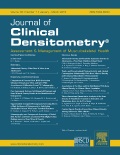
METABOLIC DISORDERS
Combination therapy improves site-specific BMD vs. teriparatide & denosumab monotherapies
This report has been verified
by one or more authors of the
original publication.
J Clin Densitom. 2016 Jul-Sep;19(3):346-51
94 postmenopausal osteoporotic women were randomized to receive either 60mg denosumab subcutaneously every 6 months, 20ug teriparatide subcutaneously daily, or a combination treatment of both 60mg denosumab and 20ug teriparatide for a duration of 24 months. The purpose of this study was to compare the individual response rates of the three treatment groups in terms of increases in bone mineral density (BMD) at the total hip, femoral neck, lumbar spine, and distal one-third radius shaft. Outcomes were assessed up to 24-month follow-up. Findings indicated a significantly greater rate of response (>3% increase in BMD from baseline) in the combination therapy group when compared teriparatide monotherapy at the total hip, femoral neck and distal 1/3 raidus sites, as well as compared to denosumab monotherapy at the total hip and femoral neck sites.
Unlock the full ACE Report
You have access to {0} free articles per month.Click below to unlock and view this {1}
Unlock NowCritical appraisals of the latest, high-impact randomized controlled trials and systematic reviews in orthopaedics
Access to OrthoEvidence podcast content, including collaborations with the Journal of Bone and Joint Surgery, interviews with internationally recognized surgeons, and roundtable discussions on orthopaedic news and topics
Subscription to The Pulse, a twice-weekly evidence-based newsletter designed to help you make better clinical decisions
Exclusive access to original content articles, including in-house systematic reviews, and articles on health research methods and hot orthopaedic topics
Or upgrade today and gain access to all OrthoEvidence content for just $1.99 per week.
Already have an account? Log in


Subscribe to "The Pulse"
Evidence-Based Orthopaedics direct to your inbox.
{0} of {1} free articles
Become an OrthoEvidence Premium Member. Expand your perspective with high-quality evidence.
Upgrade Now













































































